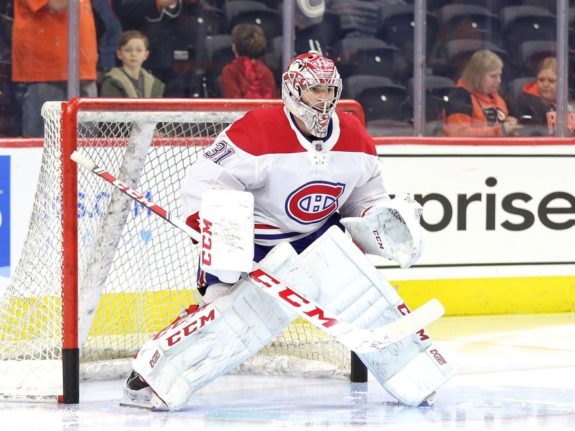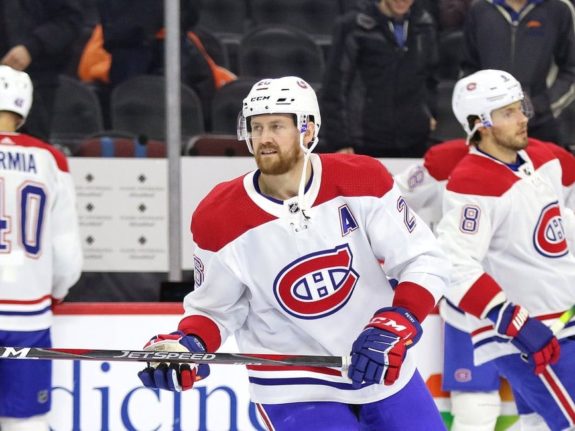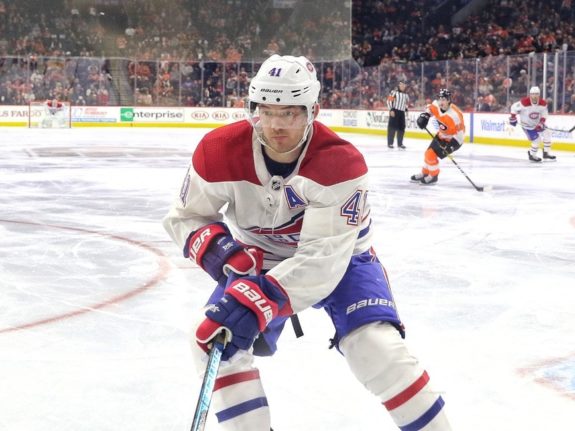In the first half of the season, the Montreal Canadiens limped to last place in the NHL, winning very few games and losing by four goals or more 10 times. They were playing lifeless hockey where the players seemed either confused about the team’s systems or just indifferent to playing it. This led to the new general manager Kent Hughes choosing to fire Dominique Ducharme only six months after he served as the head coach of the Canadiens edition that made it to a Stanley Cup Final.
Have the Canadiens really improved under interim head coach Martin St. Louis as compared to the first half of the season? Is it all just an illusion because it is a matter of a shift in expectations which is allowing fans to accept the warts of a losing team because they are letting the young core play while they provide a wide-open style of hockey that is entertaining?
Using a statistics-based approach we can compare the short tenures of each coach and how the Canadiens’ roster performed under both Ducharme and interim head coach Martin St. Louis.
Canadiens Performance at Even Strength
The first comparison will be at even strength (5v5). Here are the numbers:
Under Dominique Ducharme
Goals for per game (GF/G) 2.2 – 32nd
Goals against per game (GA/G0 3.98 – 32nd
Shots for per game (SF/G) 29.1 – 26th
Shots against per game (SA/G 34.7) – 30th
Possession stats
Corsi For percentage (CF%) 46.36 – 30th
Expected goals for percentage (xGF% ) 43.26 – 31st
High danger chances for percentage (HDCF%) 44.93 – 29th
Under Martin St. Louis
CF/G 3.16 – 18th
GA/G 3.48 – 22nd
SF/G 30.6 – 19th
SA/G 34.4 – 29th
Possession stats
CF% 46.46 – 27th
xGF% 74.03 – 14th
HDCF% 42.44 31st
Under Ducharme, the Canadiens were last in both GF/G at 2.2, as well as GA/G at 3.98. That is a combination that clearly leads to poor results, which led to a record of 8-30-7 and dead last in the NHL. The players seemed to have suffered from a Stanley Cup hangover, meaning the shortened offseason didn’t allow them to properly recover and train prior to this season beginning. With players who didn’t seem to grasp his system and even demand trades, coupled with a seemingly non-stop parade of long-term injuries, the loss of Carey Price and captain Shea Weber, as well as having months where there were as many as 16 players on the COVID protocol list at once, it’s no wonder Ducharme hadn’t been able to find any success. But professional sports is a results-oriented business, and he wasn’t able to find positive results.

Have the Canadiens improved under St. Louis? Fans have liked the style of play from his “concepts” based style, which provides structure but gives players more freedom.
But most of all, since his hiring on Fen 9, the Habs have played 25 games. They have earned an 11-10-4 record, good for 26th place, putting them slightly above a .500 winning percentage, nearly double of what it was under Ducharme. So, in all statistical categories except for HDCF%, the team has improved under St. Louis.
Related: MSL deserves to have Interim tag removed
As seen in this chart, the Canadiens have been allowing far too many shots from close. No matter who is coaching next season, they will need to work diligently on coming up with a defensive zone coverage plan that can minimize shots from the slot.
Canadiens Performance on the Power Play
On the power play (PP) under Ducharme, the Canadiens used a strict 1-3-1 approach. Meaning they had one player down low by the net, three players spread across the zone at the mid-way point of the offensive zone, and one player playing the point. The PP was a perimeter style whose only plan was to feed the puck to the point for a shot on the net in the hopes of overpowering the goaltender or generating a rebound. This approach may have worked better with Weber on the point as he had one of the best shots in the modern age, but this season with Jeff Petry, it wasn’t effective. This was proven by the 13.6% success rate leaving them 31st in the NHL with the man advantage.

Under St. Louis, the Canadiens still employ the 1-3-1, but they do so more aggressively. Instead of relying on a point shot, they use puck movement to open up passing lanes across the zone allowing for a one-timer or creating small area two-on-one situations by getting the puck down low that can then be passed into the slot to the player sitting in the middle for a quick shot. They have even used five forwards on the first wave of the PP, relying on their offensive skills in the hopes of scoring quickly. Perhaps the biggest difference between coaches has been St. Louis’ willingness to use Cole Caufield as a key PP weapon, taking advantage of his lethal shot which has given him 5 PP goals and 8 PP assists. This has led to a minute statistical improvement to 13.8% leaving them 30th in the NHL.
Canadiens Performance on the Penalty Kill
Under Ducharme, the Canadiens had the worst penalty kill (PK) in the NHL at a paltry 73%. Essentially, allowing just over one goal every four penalties are taken. The problem was compounded by the fact that at 5v5, the Habs kept losing one-on-one battles, leading to them taking even more penalties. Like any hockey team, they set a box in the defensive zone, however, they were too static, making it easier for opponents to move the puck at will and retain offensive pressure.
Under St. Louis, they began to play a more aggressive style of PK using the strengths of players like Paul Byron and Joel Armia to create pressure. They would pressure the puck carrier and shift the box, which in theory would give an ability to continue pressuring the puck carrier while also leaving them capable of using their positioning to cut off cross-ice passes.

This led to the Habs PK jumping into 21st in the NHL, but at 75.6%, was only a minor improvement. The overall improvement here was that with the Canadiens playing a more possession-style game at 5v5, they were less likely to take penalties, which left them less exposed down a man.
Canadiens Overall Performance
Overall, after 70 games, the Canadiens have been a disappointment based on pre-season expectations of being a team capable of competing for the playoffs, instead, they have fallen to the bottom of the league standings and are competing for a top lottery pick with the following statistics:
GF/G 2.54 – 31st
GA/G 3.8 – 32nd
PP 13.7% – 31st
PK 73.95% – 29th
SF/G 29.6 – 25th
SA/G 34.6 – 30th
Essentially this season demonstrates a team that had the wheels come off at the end of former GM Marc Bergevin’s tenure. This is now a team in rebuilding mode as Hughes will have to continue to aggressively press forward with adding as many top 90 draft picks and prospects as he can. Also, he will need to keep moving out veteran contracts, and more importantly, continue rebuilding the development, analytic and scouting departments. This will not be a quick turnaround to become a Cup-contending team, but Habs fans can take solace that management is intent on having the team play an entertaining brand of the modern NHL style while they wait. In the end, the Canadiens have improved under Hughes and St. Louis.